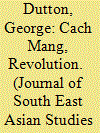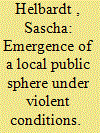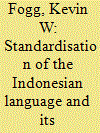| Srl | Item |
| 1 |
ID:
139602


|
|
|
|
|
| Summary/Abstract |
This article traces the etymology of the term ‘revolution’ as it developed in Việt Nam between the second half of the nineteenth and the early twentieth centuries. It argues that the term was slow to catch on, and that activists who used it did so in often contradictory ways. The term's historical development complicated efforts to fix its meaning, and it was not until the later part of the 1920s that it came to be consolidated, in part through Hồ Chí Minh's publication of a short book entitled Đường Kách Mệnh (The road to revolution).
|
|
|
|
|
|
|
|
|
|
|
|
|
|
|
|
| 2 |
ID:
139603


|
|
|
|
|
| Summary/Abstract |
Community radio has strongly changed Thailand's centralised media landscape. This article analyses community radio's role in establishing a public sphere in the context of Southern Thailand's ongoing Malay Muslim insurgency. This article argues that although the new community radio stations potentially provide ethnic communities, particularly Malay Muslims, with a chance to broadcast in their own language, these stations are dominated by middle-class broadcasters and commercial interests. More politically-oriented community radio stations in Southern Thailand feel threatened by both the Thai military's attempts to intimidate them or influence their programming as well as by militant threats to broadcasters who show favour to the Thai armed forces, which results in the self-censorship of sensitive topics. In addition, the community radio sector is fragmented between Malay Muslim and Buddhist broadcasters.
|
|
|
|
|
|
|
|
|
|
|
|
|
|
|
|
| 3 |
ID:
139605


|
|
|
|
|
| Summary/Abstract |
In the 1940s and 1950s, several organs of the newly independent Indonesian state oversaw the standardisation of the Indonesian national language. In this process, Western-oriented bureaucrats pushed the language towards European normativity, significantly decreasing the influence of Arabic. While this reform carried symbolic meaning, the practical ramifications on Indonesian orthography, spelling, and word selection also carried real, non-symbolic effects on the accessibility of this language to Indonesian Islamic leaders. Standardising orthography to use the Roman alphabet rendered many Muslims illiterate in a language they had been using for decades. Choices in word selection and spelling limited the Islamic meanings that the new language could carry, thus impacting how Muslims could use the national language for religious and other purposes. Indonesian linguistic reform carried serious social and political consequences in addition to the symbolic meanings often studied.
|
|
|
|
|
|
|
|
|
|
|
|
|
|
|
|
| 4 |
ID:
139604


|
|
|
|
|
| Summary/Abstract |
Challenging conventional wisdom, this article argues that Indonesia — long home to both large-scale transmigration programmes and a range of conflicts — has not witnessed transmigrant conflicts. The vast majority of Indonesian transmigrants were resettled in parts of Sumatra which have remained peaceful. In some conflicts, the role of transmigration has been exaggerated. In others, interethnic violence has involved spontaneous migrants rather than state-led transmigrants. We conclude with a discussion of two potential outliers, where violence has been directed towards transmigrants, but only those from disaster-affected regions who arrived en masse. This article argues for a more nuanced understanding of the distinctions between different forms of internal migration, some of which have the potential to spark future violence in recipient areas and communities.
|
|
|
|
|
|
|
|
|
|
|
|
|
|
|
|